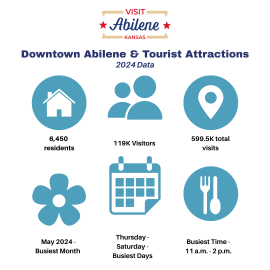Partnership Reveals Tourism Trends and Opportunities for Abilene
Abilene, Kansas – A new visitor analysis shows that Abilene continues to attract steady tourism traffic and highlights key opportunities to boost visitor spending and economic impact. The study was made possible through a partnership between the Abilene Convention & Visitors Bureau and the North Central Regional Planning Commission. It was provided at no cost to the city through the Thriving Communities program by Main Street America with support from the U.S. Department of Transportation.
In 2024, Downtown Abilene and nearby attractions welcomed 119,000 unique visitors who generated nearly 600,000 visits throughout the year. The Eisenhower Presidential Library & Museum ranked as the area’s top attraction.
Year-Round Momentum and Event Peaks
The data reveals that visitation is highest from March - October, with noticeable seasonal dips in November, January and February. Key events—such as Abilene Oktoberfest, the Abilene Downtown Antique Fest and Car Show, Symphony at Sunset Annual D-Day Commemoration, and Cowtown Christmas activities—each averaged around 5,000 visitors and created noticeable spikes in activity. May 2024 was the busiest month, but consistent traffic was recorded across all twelve months.
“Abilene has a strong reputation as a travel destination, and we appreciate the affirmation from a third-party expert,” said Julie Roller Weeks, Director of the Abilene Convention & Visitors Bureau. “It also helps guide our marketing strategy as a tourist destination.”
Local Engagement, Regional Reach
The analysis showed only 14% of visitors live in Abilene (ZIP 67410), yet they made up 56% of total visits. This reflects strong local engagement and repeat traffic from nearby communities. With a 60-minute drive market that includes 250,000 people, Abilene is well-positioned to serve day-trippers and event-based visitors, though marketing efforts must reach outside this boundary to attract overnight visitors.
Fridays and Saturdays were the busiest days, particularly between 11 a.m. and 2 p.m., with visitation declining at 7 p.m. More than one-third of visitors stayed for at least an hour, highlighting opportunities to extend visits with additional offerings.
“The more things we have for visitors to do, the longer they will stay, the more they will spend and the more likely they are to spend the night,” Roller Weeks added.
Visitor Segments and Travel Patterns
Visitor demographics revealed that most travelers fall into three key lifestyle segments:
- Pastoral Pride – Rural families from small towns who value tradition, community, and wholesome, family-friendly experiences
- Golden Year Guardians – Retirees enjoying life in established, welcoming neighborhoods
- Thriving Boomers – Active baby boomers with disposable income and a passion for meaningful travel
These groups are looking for authentic, cultural, historical, and less commercialized experiences, which make Abilene a natural fit.
The study also revealed patterns in spending. About 15% of visitors stopped at fast food or casual dining locations before or after visiting downtown or local attractions. Many began or ended their trip at convenience stores and gas stations along Buckeye Avenue.
Interstate Exit Data
Abilene’s interstate exits continue to play a key role in visitor flow:
- Exit 272 (Love’s Travel Stop) attracted 430,000 unique visitors who made 800,000 visits, primarily one-time travelers.
- Exit 275 (North Buckeye Avenue) welcomed 383,000 visitors, who generated 1.5 million visits, indicating higher local and repeat use.
The data showcases opportunities to connect with new and repeat customers and visitors.
Next Steps for Growth
While the data shows positive trends, visitation to downtown and nearby attractions remains about 19% below pre-pandemic levels. Factors such as limited hours and federal site closures continue to impact recovery.
Continued progress will rely on coordinated hours, investment in attractions, and maintaining a welcoming, visitor-ready mindset. The Abilene Convention & Visitors Bureau plans to use this data to guide future marketing efforts and identify opportunities for growth.
The data in this report is provided through Placer.ai, a location analytics company that studies trends in visits, trade areas, and demographics, with added interpretation from Main Street America (MSA). Placer’s information comes from smartphone data which tracks users’ location and duration of stay in a given area across the United States.
“We appreciate the partnership with the North Central Regional Planning Commission for helping us obtain this valuable information through the Thriving Communities program,”
Roller Weeks said. “As with all things, collaboration is key to success for our community, region and state.”
To learn more about planning a trip to Abilene, visit www.AbileneKansas.org.

